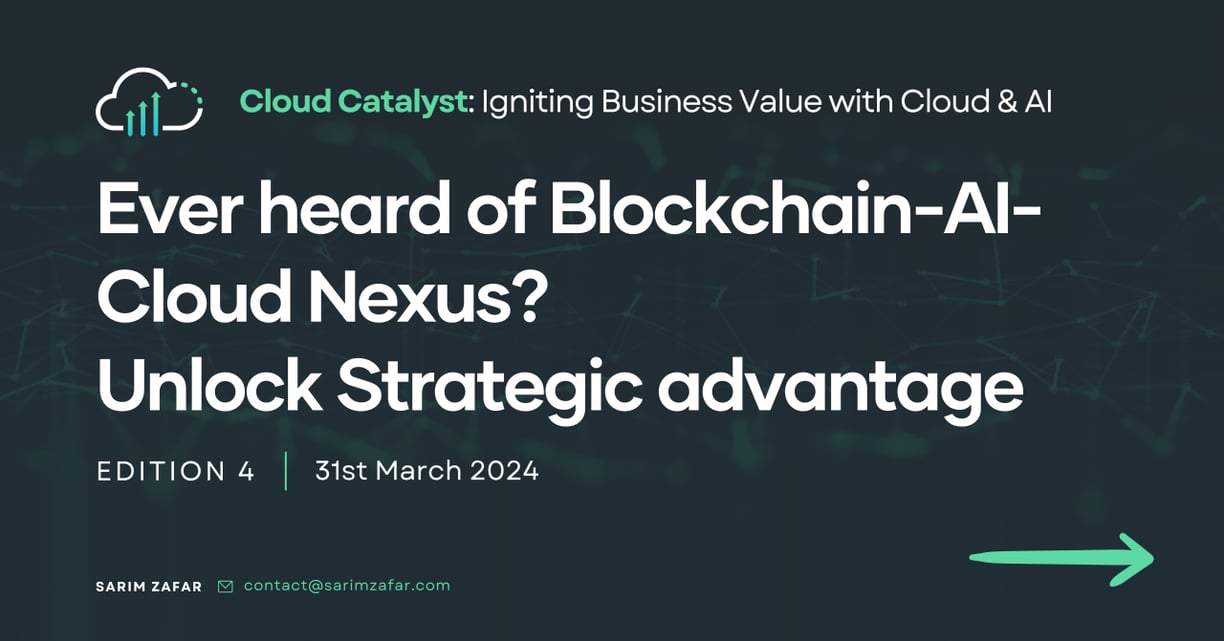Ever heard of Blockchain-AI-Cloud Nexus? Unlock Strategic advantage.


Data is the lifeblood of modern enterprises. Yet, concerns about security, AI's opaque nature, and centralized cloud limitations can hinder its full potential. Blockchain technology offers a transformative solution. It can augment AI with explainability, decentralize cloud systems, and unlock secure data-sharing models that fuel strategic decision-making.
Here are the three most prevalent cloud security myths you should be aware of:
Demystifying the blockchain
As you’re probably aware, blockchain technology is closely associated with cryptocurrency despite the fact its transformative potential extends much further, as you’ll soon see. In a nutshell, blockchain is a distributed decentralized ledger technology relying on nodes shared among computer networks. In the context of crypto, a blockchain helps maintain a secure record of all transactions, though it can also empower any technology relying on data.
Why? Simple - a blockchain can be deployed to make data immutable, meaning no information can be altered.
Blockchain and AI - a match made in heaven
Considering blockchain is known for its transparency and immutability, it can provide a new level of insight into systems traditionally labeled as opaque, such as those powered by AI:
While not inherent to all AI systems, those relying on deep learning methods are pretty much synonymous with black boxes, as there are no reliable methods of explaining their inner workings. Thus, blockchain (on paper) has the potential to provide the following improvements to AI technology:
Higher confidence in AI outputs: Despite its advancements, AI can still be hit and miss (its inability to render fingers in photos has become a thing of legend). Naturally, such blunders have affected the trust people have for AI–based systems. The easiest way to increase overall trust in AI while making it ripe for the next round of innovations is to make AI algorithms explainable. Through immutable digital records enabled by the blockchain, developers could understand the sources of data used for better insight into the underlying framework of the model.
New source of computing power: Running even a simple AI model can be resource-intensive and call for an excessive amount of computational power. Centralized servers may not have the capacity to handle such demand, but since the blockchain utilizes the processing power of multiple machines, it could eliminate any bottlenecks and speed up AI operations.
Additional level of augmentation: Blockchain can push AI to new heights by providing it with external and internal organizational data. Organizations stand to benefit from a more transparent data market through model sharing, improved data consumption management, and increased actionable insights.
Enhanced data security: With decentralized data storage, blockchain technology can supply a full audit trail, allowing insight into how companies and organizations are leveraging user data. In other words, by storing and distributing AI models through the blockchain, the decisions made by the models could transform into a fully transparent and decentralized system.
How cloud computing and blockchain can coexist
Cloud computing has proven to be disruptive with organizations benefiting from more scalability, cost efficiency, security, and fault tolerance. When combined with blockchain technology, it can drive innovation much further.
Compounding the cloud with blockchain can spark the development of applications that don’t hinge on a centralized control source, offering users more flexibility in terms of computing resources and data.
Here are some potential benefits of merging these two technologies:
Improved privacy and security: Since the cloud is already more secure than regular on-premise solutions, adding decentralization into the mix can provide more reliability and security, assisting in sidestepping the risks of keeping data in the cloud.
Higher reliability: Because of its consensus-based operation mode, blockchain can offer higher reliability. In simple terms, it operates as a peer-to-peer network, ensuring that even if some of the nodes fail, the overall network will continue working without a hitch. Merging this ability with cloud computing can lead to a seamless operation and greater availability, while at the same time fostering a transformation of the cloud into a more transparent platform.
Flexibility: Cloud computing and blockchain can theoretically allow users to gain maximum interoperability and scalability, with blockchain technology primarily implementing a robust data verification method.
Are there real-world use cases?
The fine dance between these technologies isn’t just theoretical. There are companies out there actively working to move the advances in implementing blockchain in AI and cloud computing further, two of which include:
Bext360: This company combines AI and blockchain to enhance supply chain transparency in the timber, coffee, mineral, and seafood industries. Its algorithms analyze growing patterns of crops to make accurate predictions, while blockchain makes sure the entire process of a product’s supply chain records is transparent from the initial seed planted to the shipped product. In addition, with blockchain technology, Bext360 acts as a payment ledger to protect all the parties involved.
LifeGraph: This platform combines blockchain and AI tech to enhance the management and ownership of patient data, allowing healthcare professionals to create secure storage solutions for wellness plans and sensitive patient records. All the applications made with LifeGraph are fully GDPR- and HIPAA-compliant.
Storj: A real-world example of how well cloud and blockchain technology can work together, Storj is a cloud-based storage platform that uses blockchain to boost security, privacy, and efficiency. Its peer-to-peer network allows users to rent out unused storage space in exchange for a crypto coin referred to as Storj. As a cost-efficient alternative to traditional cloud storage, Storj utilizes the extra storage capacity of its users to create a fully decentralized network, emphasizing privacy and community-based development. Because it uses sharding and redundancy techniques to distribute user data across various nodes, the system is safe and ensures users can access the network even if some nodes go offline.
Start embracing change
While powerful in isolation, these real-world applications prove just how extraordinary these technologies can be when combined.
There’s a long path ahead but considering how many companies are already experimenting with implementing blockchain as a means to enhance security and reliability in more traditional applications, whatever new frontier we come across, it will surely be exciting to see.
About Me



